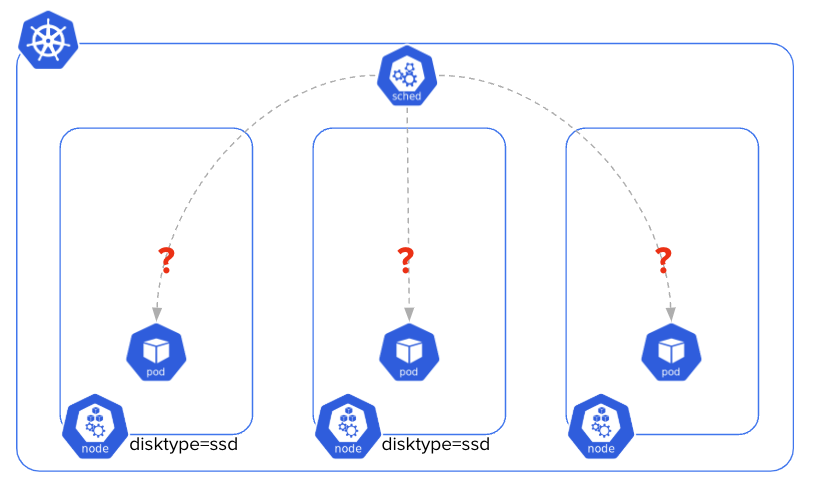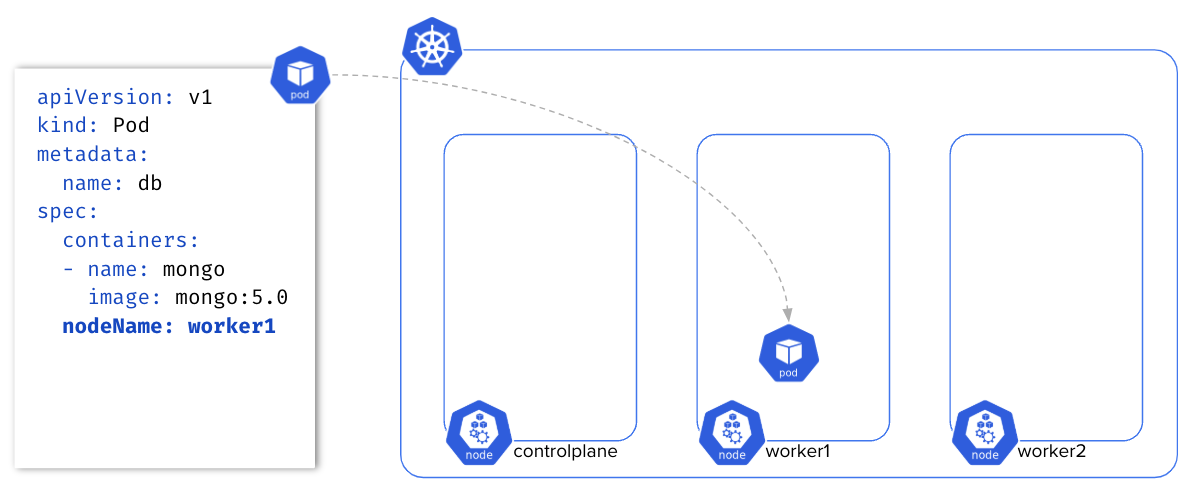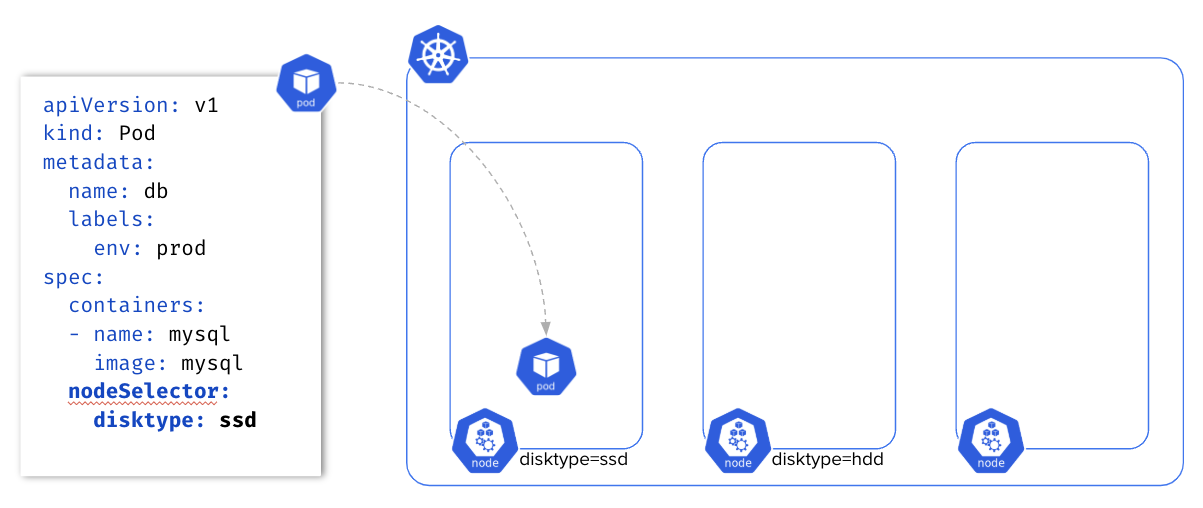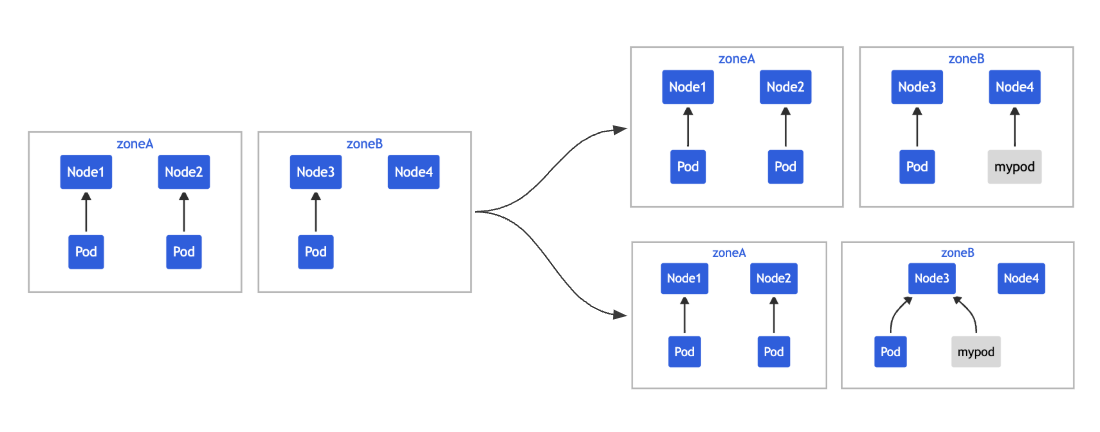Scheduling Pods
This section is a refresher that provides an overview of the main properties involved in the scheduling phase. At the end of this section, please complete the exercises to apply these concepts.
Purpose 🔗
The scheduling step is where Kubernetes decides on which Node a Pod will run on. The Scheduler, running on the control plane, is the process in charge of this action.

There are various properties/items which can influence the scheduling decision, including:
nodeNamenodeSelectornodeAffinitypodAffinity / podAntiAffinitytopologySpreadConstraintstaint / tolerationavailable resourcespriorityClassruntimeClass
nodeName 🔗
The nodeName property bypasses the scheduling process, indicating directly in the Pod’s specification the name of the Node this Pod must be deployed to.

nodeSelector 🔗
The nodeSelector property uses Node’s labels to schedule a Pod.

nodeAffinity 🔗
The nodeAffinity property also uses Node’s label. Still, it is more granular than nodeSelector as it can use the following operators on the labels: In, NotIn, Exists, DoesNotExist, Gt, and Lt.
Two rules are available when using nodeAffinity:
requiredDuringSchedulingIgnoredDuringExecutiondefines a hard constraint: if the scheduler does not manage to schedule the Pod according to the specification, then the Pod will remain in PendingpreferredDuringSchedulingIgnoredDuringExecutiondefines a soft constraint: if the scheduler does not manage to schedule the Pod, according to the specification, then it will do its best to schedule it anyway, even if the requirements are not satisfied
Example: 🔗
spec:
affinity:
nodeAffinity:
requiredDuringSchedulingIgnoredDuringExecution:
nodeSelectorTerms:
- matchExpressions:
- key: kubernetes.io/e2e-az-name Pod must be scheduled on a node having the label
operator: In kubernetes.io/e2e-az-name with the value e2e-az1 or e2e-az2
values:
- e2e-az1
- e2e-az2
preferredDuringSchedulingIgnoredDuringExecution:
- weight: 1
preference:
matchExpressions: Pod preferably scheduled on a node having the label
- key: disktype disktype with the value ssd
operator: In
values:
- ssd
podAffinity / podAntiAffinity 🔗
We use the podAffinity and podAntiAffinity properties to schedule a Pod based on the labels of already existing Pods.
It uses the same rules as the nodeAffinity property:
requiredDuringSchedulingIgnoredDuringExecutiondefines a hard constraintpreferredDuringSchedulingIgnoredDuringExecutiondefines a soft constraint
It also uses a property named topologyKey to specify geographical preferences (among other things):
hostnameregionaz- …
Example 1 🔗
The following Deployment’s Pods cannot all be created on a cluster with less than 4 Nodes as it specifies that two Pods with the app: cache label must not be on the same Node.
apiVersion: apps/v1
kind: Deployment
metadata:
name: cache
spec:
replicas: 4
selector:
matchLabels:
app: cache
template:
metadata:
labels:
app: cache
spec:
containers:
- name: redis
image: redis:6
affinity:
podAntiAffinity:
requiredDuringSchedulingIgnoredDuringExecution:
- labelSelector:
matchExpressions:
- key: app
operator: In
values:
- cache
topologyKey: "kubernetes.io/hostname"
Example 2 🔗
The following specification illustrates the usage of both podAffinity and podAntiAffinity properties.
spec:
affinity:
podAffinity:
requiredDuringSchedulingIgnoredDuringExecution: Pod must be scheduled on a node which is in the availability
- labelSelector: zone where already exists a Pod with the label security: S1
matchExpressions:
- key: security
operator: In
values:
- S1
topologyKey: failure-domain.beta.kubernetes.io/zone
podAntiAffinity:
preferredDuringSchedulingIgnoredDuringExecution: Pod should not be scheduled on a node where already exists
- podAffinityTerm: a Pod with the label security: S2
labelSelector:
matchExpressions:
- key: security
operator: In
values:
- S2
topologyKey: kubernetes.io/hostname
TopologySpreadConstraints 🔗
The topologySpreadConstraints property defines how to spread Pods across a cluster topology, ensuring application resiliency.
The following Deployment uses the topologySpreadConstraints property to ensure Pods are correctly balanced between AZ and Node.

apiVersion: apps/v1
kind: Deployment
metadata:
name: www
spec:
replicas: 4
selector:
matchLabels:
app: www
template:
metadata:
labels:
app: www
spec:
containers:
- name: nginx
image: nginx:1.24
topologySpreadConstraints:
- maxSkew: 1 The difference in the number of matching Pods between
topologyKey: "kubernetes.io/hostname" any two nodes should be no more than 1 (maxSkew)
whenUnsatisfiable: ScheduleAnyway
labelSelector:
matchLabels:
app: www
- maxSkew: 1 Ensures that the Pods are spread across different
topologyKey: "topology.kubernetes.io/zone" availability zones
whenUnsatisfiable: ScheduleAnyway
labelSelector:
matchLabels:
app: www
Taints & Tolerations 🔗
In contrast to the properties we saw earlier, we use a Taint to prevent certain Pods from being scheduled on a node. A Pod must tolerate a Taint, using a toleration property, to be scheduled on a Node having that Taint.
A Taint has 3 properties:
key: it can be arbitrary string content, same format as labelsvalue: it can be an arbitrary string content, same format as labelseffect: amongNoSchedule,PreferNoScheduleandNoExecute
By default, a kubeadm cluster sets a Taint on the control plane Nodes. This Taint prevents a Pod from being deployed on these Nodes unless the Pod explicitly tolerates this Taint.
The following command lists the Taints existing on the controlplane Node.
$ kubectl get no controlplane -o jsonpath='{.spec.taints}' | jq
[
{
"effect": "NoSchedule",
"key": "node-role.kubernetes.io/control-plane"
}
]
When creating the following Deployment, with 10 replicas of nginx Pods, none of the Pods will land on the controlplane because of this specific Taint.
apiVersion: apps/v1
kind: Deployment
metadata:
name: www
spec:
replicas: 10
selector:
matchLabels:
app: www
template:
metadata:
labels:
app: www
spec:
containers:
- image: nginx:1.24
name: nginx
We must add a toleration for the Taint, so the scheduler can schedule Pods on the controlplane.
apiVersion: apps/v1
kind: Deployment
metadata:
name: www
spec:
replicas: 10
selector:
matchLabels:
app: www
template:
metadata:
labels:
app: www
spec:
tolerations:
- key: node-role.kubernetes.io/control-plane
effect: NoSchedule
containers:
- image: nginx:1.24
name: nginx
PriorityClass 🔗
A PriorityClass is a Kubernetes resource that defines the priority of Pods. It influences scheduling decisions and preemption - meaning that higher-priority Pods can evict lower-priority ones if resources are scarce. A PriorityClass can be preempting (default behavior) or non-preempting, depending on the preemtionPolicy property.
The following specifications define a high-priority PriorityClass and a Pod using it.
apiVersion: scheduling.k8s.io/v1
kind: PriorityClass
metadata:
name: high-priority
value: 1000000
globalDefault: false
---
apiVersion: v1
kind: Pod
metadata:
name: nginx
spec:
containers:
- name: nginx
image: nginx
priorityClassName: high-priority
RuntimeClass 🔗
A RuntimeClass allows to have multiple container runtimes in the cluster, and to select the one which best fits a workload. There are several container runtimes, each one of them addresses specific use cases, including:
- Containerd is a general-purpose container runtime (CNCF Graduated)
- CRI-O is a light container runtime focusing on Kubernetes (CNCF Graduated)
- GVisor is used to run an unsecure workload in a sandbox
- Kata-Container uses Micro VMs for workload isolation
- Firecracker uses Micro VMs, mainly for serverless
- WasmEdge is dedicated to run Wasm workload
In a Pod specification, we can specify the container runtime configuration needed by this workload. The scheduler ensures that Pods are placed on Nodes that support the required container runtime configuration.
Let’s say our cluster already has a RuntimeClass named gvisor, then we can use it in the Pod specification as follows.
apiVersion: v1
kind: Pod
metadata:
name: nginx
spec:
containers:
- name: nginx
image: nginx
runtimeClass: gvisor
Practice 🔗
You can now jump to the Exercises part to learn and practice the concepts above.